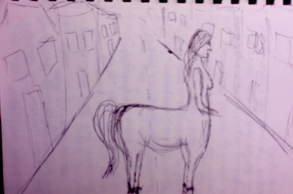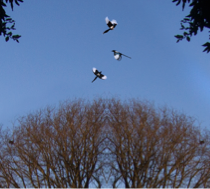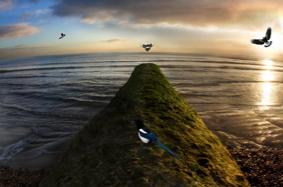My initial concept was to create a series of fantastical, beautiful images with a gritty street twist. As a photographer I have always been interested in other artists who use their camera to paint their inner vision and the post-production techniques needed to effectively execute this style of photography. I had previously explored this growing genre of conceptual fine art photography in a similar style as shown below. However my principle motivation for this project was to move away from the inevitable mysterious isolated location and stereotypical maiden to produce my own take with the introduction of an urban backdrop.
My intention was to use the streets of Brighton as the foundation to a heavily processed final image incorporating my theme of superstition, myth, magic and legend.
Following my second shoot in Queens Park it became clear to me as I analysed and evaluated photographs taken so far, that I preferred the images to be undisturbed and decided to break away from such a heavily manipulated approach. I decided that a fisheye lens was my ideal choice, as it gave me freedom and flexibility to distort my image or not at the point of capture, with the added advantage of minimum fuss and equipment whilst out shooting. The decision to change direction and move forward with untouched landscape photographs made a natural divergence away from myth and legend and a wider exploration into superstitions connected to landscapes, the countryside and country living. My research into superstition and folklore took me to The Novium Museum talk “Superstition in West Sussex”. I investigated the background and circumstances of the Cottingley fairies, which has long been a source of personal interest, which reaffirmed my revised intention to incorporate realistic fantasy in to my landscape photographs.
Superstition and folklore covers such a wide spectrum that it was necessary to choose a device to forge a link and continuity between images. Magpies feature in many superstitions, are well known to the majority of people as well as being striking and attractive birds. I experimented with mirroring the image producing the following photograph, which holds strong references to the uterine Fig Tree discussed in my dissertation.
When assessing and critiquing this pair of images I concluded that whilst the motif was successful with the landscape it was significantly less so with the seascape as the magpies were simply too incongruous. Peer feedback regarding the colours, curves and tranquil atmosphere shared between the images encouraged me to pursue capturing and producing those qualities in future photographs.
Continued research endorsed my view that superstition linked with location was the key to developing a more aesthetically sound collection. Local history in Sussex is rich with superstition and folklore linked to notable landmarks such as Devil’s Dyke and the Devil’s Humps, which was a strong initial source of inspiration for the project.Furthermore the impetus to make Sussex the overall location for a landscape project came from the fact that this has been my home for three years during my photographic journey. I wanted to celebrate the final stages of this by producing a collection of photographs that captured the essence of this part of the country.
The project was developing and taking me on a natural progression from using post production techniques to inject a connection with superstition into the photograph to exploring and developing the connection with superstition through location. I sought a more authentic painterly appearance through an exploration of camera techniques and decisions with minimal post-production tweaking only. To achieve optimum exposure in my photographs I use the bracketing technique, taking many exposures of the same shot. These can then be layered together using post-production software for a seamless exposure. In my work I prefer to use the underexposed shots as they record all of the detail available and with minimal tweaking they can produce dramatic shadows. Sunrise and sunset enhance the potential of these shadows as well as offering a golden quality of light that infuses the image with spectacular warm, glowing natural colours. This authentic range and tone is specific to these times of day, known as the golden hour, and cannot be achieved with the use of a simple filter. Photographs taken at this time hold an atmospheric aura that eludes those taken at other times throughout the day and give the image an inherent magical quality.
I researched current landscape photographers and was particularly drawn to and inspired by UK photographer Adam Burton. He uses the camera’s abilities, together with favouring dawn/dusk time slots, to take advantage of the natural light at its very best to capture authentic and natural photographs free from digital manipulation.
Following the path of researching location rooted in superstition brought me to an awareness of nature and our connections to our planet. Wide, open locations such as Devil’s Dyke, Ditchling Beacon and Beachy Head where man-made structures are sparse are ideal for emphasising and communicating our link with the earth. Reproduction, the circle of life and Mother Nature all bring forward circular connotations and as such form an intrinsic part of my project. The rounded, curved photographs produced by the fisheye lens enhance and highlight the earth’s curvature, connecting and reminding the viewer that we to are a part of the earth. We all know that our planet is a sphere, but perhaps are not constantly conscious of this fact as it is in towns and cities
Notes
- I wanted to combine fantasy with reality – our reality in todays world
- Superstition brought me to the locations that gave me the realisation that we are part of a planet
- In the olden days it was believed the world was flat
- It was once believed that the world was flat and superstition and folklore strongly influenced the way in which people lived day to day.
- Superstition has brought me to where I am in this project.
- Local history in Sussex is rich with superstition and folklore linked to notable landmarks such as Devil’s Dyke and the Devil’s Humps, which was a strong initial source of inspiration for the project.
- The impetus to make Sussex the overall location for a landscape project came from the fact that this has been my home for three years during my photographic journey and I wanted to celebrate the final stages of this by producing a collection of photographs that captured the essence of this part of the country
- progression from using post production techniques to inject a connection with superstition into the photograph to exploring and developing the connection with superstition through location.
- exploration of camera techniques and decisions with minimal post-production tweaking only
- Adam Burton
- Alex Koloskov
- Triptych – Francis Bacon
- Wes Anderson
- time of day – sunlight
- what works what doesnt work with the curvature accent from the fisheye lens – the canyon vs sea horizon. Foreground and background what makes it work/doesn’t work
- It was once believed that the world was flat and superstition and folklore strongly influenced the way in which people lived day to day.
- Superstition has brought me to where I am in this project.
- Adam Burton
- Alex Koloskov
- Triptych – Francis Bacon
- Wes Anderson
- time of day – sunlight
- what works what doesnt work with the curvature accent from the fisheye lens – the canyon vs sea horizon. Foreground and background what makes it work/doesn’t work
- Using the camera as opposed to Photoshop to distort the images
- This is in order to reveal natural truths
- This circles back to my title and statement Real Fantasy, Imagined Reality.
- “I’ve always been intrigued and excited by how photography skills and techniques can influence the truth of a photograph”
- My photographs are taking away the truth of what the naked eye sees and adding what it can’t
- It’s softening the dichotomy between truth and fantasy.






